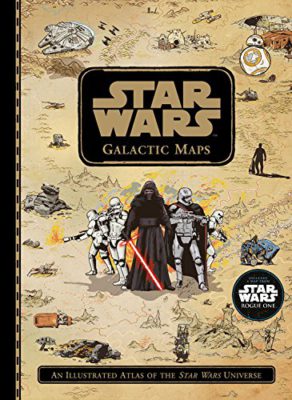 Rogue One: A Star Wars Story made me want to rewatch the entire original trilogy. And with Star Wars: The Last Jedi just 11 months away, my need for more Star Wars has become insatiable. To feed my hungry appetite, Disney recently published Star Wars: Galactic Maps, a great guide to the galaxy.
Rogue One: A Star Wars Story made me want to rewatch the entire original trilogy. And with Star Wars: The Last Jedi just 11 months away, my need for more Star Wars has become insatiable. To feed my hungry appetite, Disney recently published Star Wars: Galactic Maps, a great guide to the galaxy.
Billed as “An illustrated atlas of the Star Wars Universe,” the cover makes it look like the interior of a J. R. R. Tolkien novel. And indeed, this book allows fans to marvel in that level of Star Wars geekery. The real author of this tome is Emil Fortune, who really knows his Star Wars as he goes in depth on many of the planets visited throughout the films and television series.
Inviting you into this world is an introduction by Amel Fortoon, Director of the Graf Archive. A galaxy map divides it into 9 explainable regions and a timeline helps retell the entire saga in chronological order, including key moments from The Clone Wars, Rebels and Rogue One in addition to the 7 anthology films. The timeline divides years into BBY and ABY, which stands for Before (and After) the Battle of Yavin. For this reason, knowledge of AD and BC are recommended for any kids to understand the backwards years for BBY events.
Zooming in on the map from top to bottom, the book goes into greater detail on each planet. Each of these pages contains nearly 20 planets apiece and the subsequent pages in each section offer detailed artist renderings of each world’s inhabitants. This is where it begins to feel even more like a Tolkien map book. Throughout each map, key events are highlighted with artwork and an explanation, including the year it takes place in the timeline.
Planets that get the star treatment are Dathomir, Yavin 4, Mon Cala, Mortis, Lothal, Coruscant, Kashyyyk, Mandalore, Jedha, Jakku, Endor, Rodia, Geonosis, Tatooine, Christophsis, Naboo, Ryloth, Kamino, Dagobah, Bespin, Utapu, and Mustafar. Each of these pages feature amazingly detailed art by illustrator Tim McDonagh. In addition to these worlds, key battle moments are also depicted for the Battle of Yavin, Starkiller Base, Battle of Endor and Battle of Hoth.
A section in the early pages depicts historical figures from the saga with images and a brief bio. At the end of the book, there is also a size chart for many of the creatures that are depicted on the maps, with the Zillo Beast topping them all as the largest.
Star Wars: Galactic Maps is recommended for ages 8 to 12, but I would revise that suggestion to simply 8 and up. Adult fans could certainly find more detailed looks at the worlds within the Star Wars Universe, but would be hard pressed to find one that contains so much information in such a quick read. And while I was not a big fan of The Clone Wars, reading about some of the more exciting episodes in this book has caused me to revisit the series.
